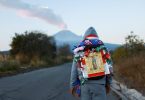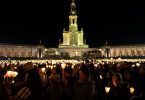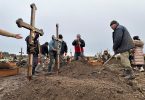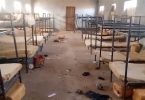
by Rhina Guidos
SAN JOSÉ, Costa Rica (OSV News) — In the masses of migrants Scalabrinian Sister María Angélica Tiralle has seen pass through Costa Rica over the past 10 years, she has seen the “people of Israel,” she said.
“It is the same people of Israel looking for the promised land,” Sister Tiralle said about the thousands of migrants she and other women religious in Costa Rica have helped, as they pass through or stay in the country.
Long thought of as one of the most stable nations in Central America, Costa Rica has opened its doors and hearts to people seeking relief during historic periods of instability in other nations, something that is reflected in the diversity of people from neighboring — and not-so-neighboring — countries who now reside in San José, its capital.
However, in recent years, Costa Rica has become a place where itinerant flows of people fleeing growing economic and political crises in Latin America mingle. While some stay, others go.
More and more, in its streets and towns, masses of migrants from countries such as Haiti and Venezuela gather to take a short break before continuing on their way to the United States. There also are migrants from Nicaragua escaping the political repression of their country or seeking means of subsistence unavailable in their homeland.
With the ongoing arrival of migrants, religious sisters from various congregations in Costa Rica have felt the need to respond to the growing phenomenon of immigration, even if their charism is not directly rooted in serving migrants. Since 2015, waves of migrants, some waves bigger than others, have arrived in the country in numbers never seen before, Sister Tiralle said.
“First it was the Cubans in 2015, then, in 2016, the Haitians, then the Nicaraguans came, and last year, the wave of Venezuelans, which was an impressive migration,” Sister Tiralle told Global Sisters Report.
In 2022, many of them were part of the 250,000 migrants who crossed — and survived — the dangerous jungle that connects South and Central America, known as the Darién Gap. It was a record number, according to figures from the government of Panama, which also has reported that, in the first months of 2023, more than 100,000 people have crossed it.
Last year, many of them arrived in Costa Rica: some hungry, some with children, barefoot, some in a state of shock, and others disheveled. But by then, the sisters already had experience serving masses of people. In 2018, after the economic crisis that broke out in Venezuela, the streets of the Costa Rican capital began to fill with migrants like never before. Some set up tents on the streets. With signs, they asked for food and money to continue their journey; others sold candy to make some profit to support themselves.
“When we saw this, we said: ‘We have to respond,’ and one day, we went all over San José distributing bags of food,” recalled Sister Verónica Cortez Méndez, a Carmelite Missionary who had worked with Sister Tiralle in a network of religious sisters, combating human trafficking. “It was Sister Angélica. . . . A spark was ignited in her,” Sister Cortez said.
Sister Tiralle began to interview migrants on the streets to see what they needed and communicated it to the other congregations, who looked for ways to help, Sister Cortez said.
“We decided to join forces,” explained Sister Tiralle, referring to the religious congregations that offered to help, including the Sisters of the Good Shepherd, the Missionary Sisters of Charity, and several Carmelite and Franciscan communities, among others.
Sister Doribel Matamoros said that although the work of the Sisters of Charity of Santa Ana, of which she is a member, focuses on schools and homes for the elderly, pastoral outreach is part of their charism, which is why they joined the mission of helping migrants.
“I feel that since our charism is so broad, we were able to attend to all their needs: from providing food and spiritual care to providing psychological support,” Sister Tiralle said, adding that the Scalabrinian community also has become involved in a national response to migration as part of civil society groups. She is a member of the Permanent Forum on Migrant and Refugee Population in Costa Rica.
Like other religious sisters, her work with migrants has led her to become familiar with immigration procedures and laws, learning about the possibilities that Costa Rica offers for migrants, how to obtain refugee status, and what to do to ensure that a person who arrives in the country feels protected and recovers his or her dignity, she said.
The sisters’ work helps people like Elquin Lozano, a Colombian immigrant who was on one of San José’s main streets March 31 with his wife and three children, including the youngest, María Angel, who is just 2 years old.
Lozano recounted that he fled his country due to the economic situation, seeking, with his wife, to support the family; however, he did not imagine how difficult it would be. The people who guided them through the jungle told them to bring food for two days, but the journey lasted 13.
“We almost died of hunger,” Lozano told GSR.
One of his daughters came out of the jungle traumatized after seeing a Haitian woman drown in the waters of a swollen river; sometimes, his daughter claims to still see the woman. And she was not the only dead person they saw along the way.
But even after all they have been through, Lozano is grateful: “We owe a lot to God. We are alive because of God. Many families that were with us in the Darién [jungle] died, and we came out as a complete family.”
His dream is to get documents to stay legally in Costa Rica, and then find a house, job, food and peace, he said.
Many others continue on, heading north despite the dangers they’ll face. Sometimes it is difficult for the sisters to communicate to the migrants the risks.
“Venezuelans are passing through, and they have their minds made up: They are going to the United States, whatever it takes,” said Hazel María Jiménez Eduarte, a consecrated laywoman associated with the Missionary Sisters of Charity.
Jiménez has been involved with the response of the religious community to the migrants who have arrived in Costa Rica, but she also is part of the migrant ministry of her parish in Guadalupe, a city near San José.
The Missionaries of Charity, even though their focus is to operate homes for the elderly, also contributed by preparing food and providing groceries when waves of migrants arrived in Costa Rica, Jimenez said.
Raising funds to finance the assistance that women religious provide to migrants has not been easy. Some organizations worldwide still have an idea of a “self-sustaining” Costa Rica, Sister Tiralle said. But in reality, there is a great need, and every day, with the waves of migrants that arrive, more resources are needed.
At the recent Davos Forum in January, President Rodrigo Chaves said that Costa Rica needs support “to continue being equally generous” with those who pass through its land, as the migratory phenomenon that affects the country costs between $200 million to $300 million annually.
On March 31, far from the halls of power that often decide the future of migrants, Andreína González, a 24-year-old Venezuelan mother, was with her 10-month-old daughter, Yulianis, outside a business along “the boulevard,” the Central Avenue of San José, where it’s easy to spot migrants waiting for alms.
“We are in a horrible economic crisis,” González said, referring to Venezuela, adding: “It is not what it used to be. So what else could we do? Emigrate to another country.”
Like other fellow Venezuelans, she decided to head to the United States despite the danger because, for her family, staying in her country meant that “if you eat in the morning, you don’t eat in the afternoon.”
She regrets leaving a daughter in Venezuela, but because the girl has a medical condition known as “crystal bones” disease, she was not going to survive the chaotic and dangerous journey, González said.
While crossing the Darién Gap, the family lost their food and shoes in the chaos, but they all survived eight days with donations from Haitian families, she said. Despite the adversities, their path was paved with generosity. In Panama, people gave them clothes for the children, as well as food and money to keep going.
“I go in the name of God. Let me pass through,” she said. “I’m not here by choice. I’m here because I need to feed my children.”
Stories like González’s are recorded in notebooks where Sister Tiralle documents some of the stories of people seeking help whom she has met in her ministry.
Sister Tiralle said that she has learned a lot from the faith of those who migrate. Some, despite the difficulty of the journey, especially through the Darién jungle, travel with a Bible and refuse to leave it behind, she said.
Sometimes, Sister Tiralle said, it’s painful to say goodbye to them, thinking of the possible dangers ahead. She mentioned the March news about the death of at least 38 migrants who died after a fire broke out in a detention center in Mexico.
“It makes you want to say: ‘God, why? Why is this happening? Why do these things have to happen to humanity?’ But you have to be strong,” she said. “You have to be strong and listen to the person and know how to help. That’s what’s important.”






